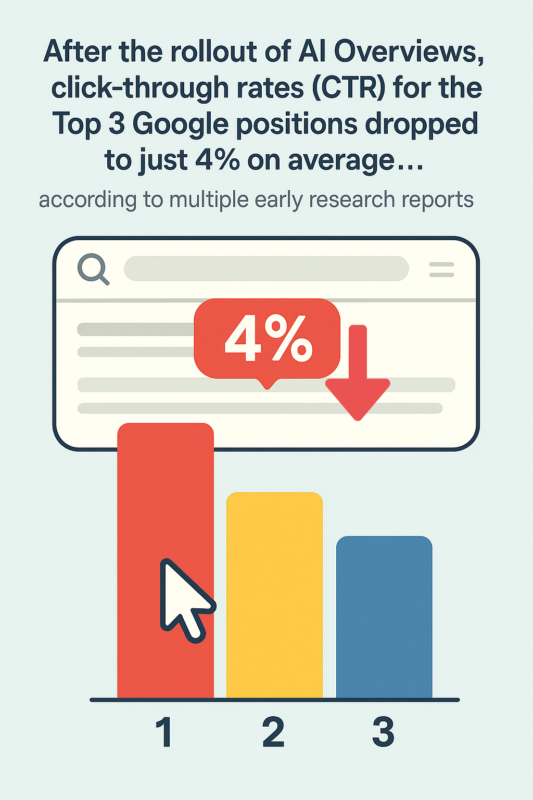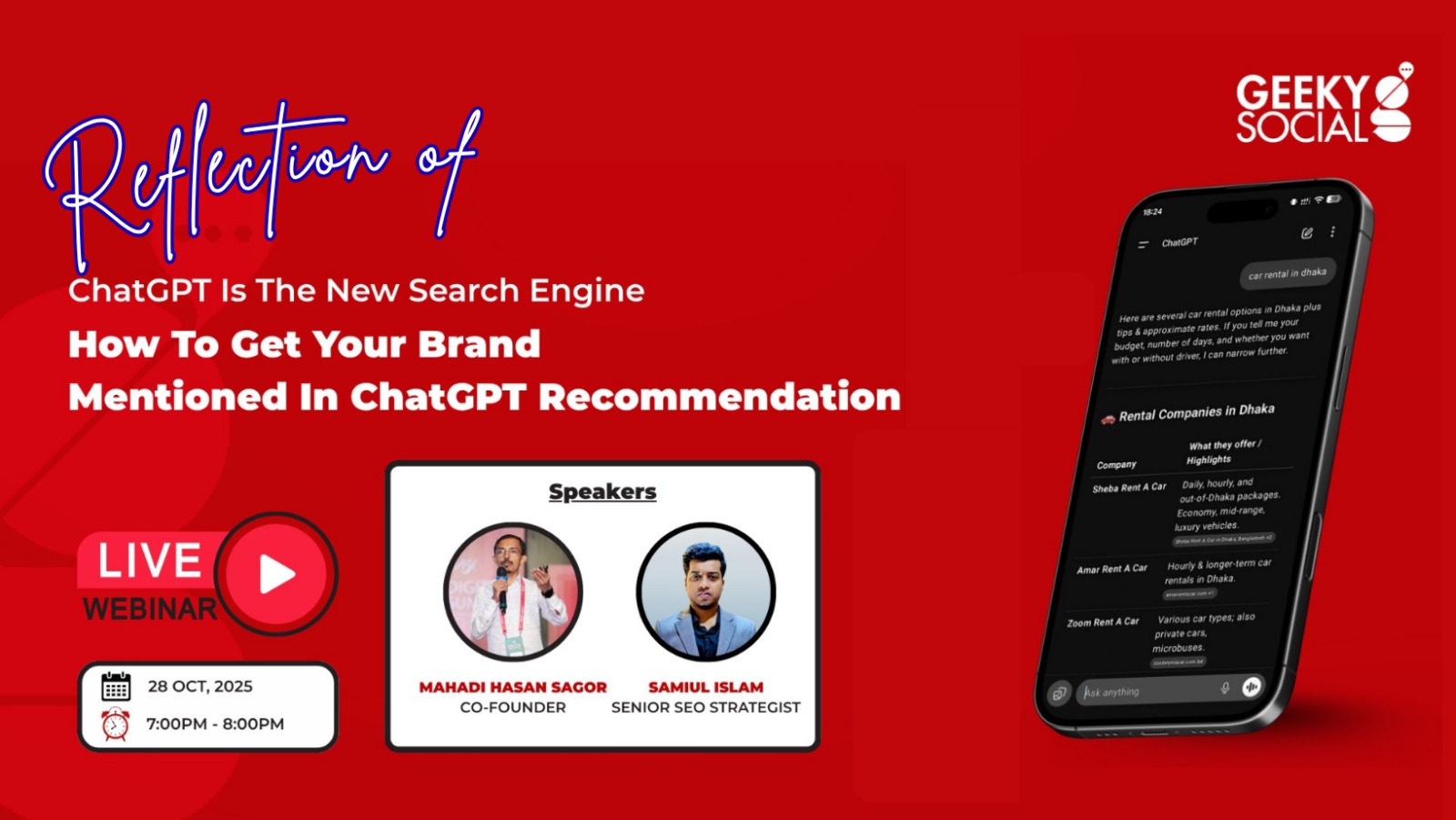
How to Rank in AI Overviews for Google Search
- Published on

Table of Contents
“It’s not about where you rank. It’s about how you speak.”
— And this is truer than ever in the age of AI-powered search.
AI Overviews have officially changed the rules of SEO.
With Google’s AI Overviews now showing up for more queries, the battle for the top spot is no longer just about traditional blue links. This led to a click-reduction by 34.5%, according to a study by Ahrefs. But the good news is AI Overviews pull and combine data from anywhere and also cite the source regardless of which position or page you’re in!
In this guide, we’ll break down how AI Overviews work, why traditional rankings matter less than ever, and what you can do to optimize your content to be featured in AI-generated responses.

What Are AI Overviews?
AI Overviews are AI-generated summaries that appear above the regular search results for certain queries in Google. They compile information from multiple web sources and present a manufactured answer directly in the SERP.
This is already impacting user behavior.
Why This Matters (Especially for Brands)
Traditionally, the top 3 organic results captured the lion’s share of clicks.
But now?
AI doesn’t care if you rank #1 — it cares if your content answers the question clearly.
That’s actually great news for smaller brands and sites without massive backlink profiles or domain authority. AI tools like ChatGPT, Claude, Perplexity, and Google’s own AI Overviews often source from pages buried deep in the SERPs — even page 3 or beyond.
How AI Chooses What to Show
Google hasn’t revealed the exact algorithm behind AI Overviews, but emerging data indicates 3 clear patterns:
1. Content That’s Quotable
AI prefers content that feels like a direct, clean, and standalone answer. Think short paragraphs, clear definitions, and punchy takeaways — not SEO-fluff or keyword soup.
Example:
“Local SEO is the process of optimizing your online presence to attract more business from relevant local searches.”
“When it comes to local SEO, businesses near me need to understand that keywords and backlinks play a vital role in increasing visibility in Google local packs.”
2. Clarity & Structure
AI parses through massive volumes of data quickly. Content that’s organized in headers, bullet points, FAQs, and chunked insights is more likely to get picked.
3. Intent Alignment
It’s not about using exact-match keywords. AI cares more about whether your content satisfies the query’s intent.
Want to Be in AI Overviews? Focus on What AI Understands and Trusts
Interestingly, AI Overviews don’t just rely on traditional SEO signals, they are influenced by how clearly you communicate, how often your brand is mentioned, and how widely your content is trusted across the web. Here’s how to improve your chances of being featured:
1. Optimize for Conversational Queries
Not all keywords trigger AI Overviews. In fact, traditional transactional or navigational keywords rarely do. AI Overviews are more likely to appear for:
- Informational queries
- Exploratory or comparative searches
- Conversational, question-based phrases
Try searching for:
- “Difference between UHT milk and pasteurized milk”
- “How to tell if a skincare product is truly organic?”
- “What makes an energy drink effective?”
These are the kinds of searches where Google wants AI not just to rank and list them, but to integrate multiple sources. So, if you try to optimize for these queries, you will have a good chance to show up on AI Overviews considering a few other factors below.
2. Build Brand Trust Through PR, Mentions, Influencers and Social Signals
AI tools are increasingly picking up content and citations from high-authority platforms, brand mentions, and wider digital conversations. That includes:
- Mentions in trusted publications via Digital PR
- Consistent brand presence on forums like Quora and Reddit
- Engagement-driven threads and discussions on X (formerly Twitter) and LinkedIn.
- Thought leadership content that gets quoted or cited by others
- Collaborating with Influencers from your niche
Content Credibility and Social Validation are the key factors for AI Overviews to consider your spot. If your brand is being discussed or cited in contextually relevant places, it increases your chances of being selected as a trustworthy source.
3. Don’t Ignore Technical SEO and Authority Signals
While AI is changing the rules, foundational SEO still matters when it comes to crawling, indexing, and content structure.
Here’s what we focus on at GEEKY Social for our clients:
- Fast load times, mobile optimization, and indexable content
- Deploying Schema Markup to help AI better understand your content and context
- Internal linking to guides AI and search engines through your topical authority
- Creating a diversified Backlink Profile. Yes, AI looks past rankings but authoritative domains still get prioritized
Even if you rank on Page 3, having a strong domain authority and clear page structure can make your content quotable and AI-friendly.
Don’t Worry About Doing This Yourself - That’s What We’re Here For
If you’re a Brand Manager, your focus shouldn’t be figuring out which keywords trigger AI Overviews or how to structure bullet points for maximum visibility.
That’s our job.
At GEEKY Social, we stay ahead of shifts like AI Overviews so your brand doesn’t fall behind. Our team actively monitors:
- Conversational search trends through People Also Ask data
- Autocomplete patterns to find how real consumers speak
- AI-focused tools like AlsoAsked and AnswerThePublic
- Advanced keyword analysis using Ahrefs’ Questions filter and intent-based segmentation
- Utilizing forums like Quora, Reddit and Twitter threads to identify product-related concerns and information gaps from users
We then turn those insights into SEO strategies that help your brand appear in AI-generated answers. Because while AI is rewriting the rules of visibility, you still need experts to speak the language.
If you want to know how your brand can show up in AI Overviews and not get left behind, get in touch with us. We’ll walk you through what it takes and handle the heavy lifting.
A Quick Checklist to Be AI-Visible (Not Just Search-Ranked)
|
✅ Do This |
❌ Avoid This |
|---|---|
|
Write clearly and concisely |
Keyword-stuffing or jargon |
|
Use bullet points and headers |
Walls of text |
|
Target long-tail, conversational queries |
Only targeting high-volume head terms |
|
Answer questions directly |
Stretching things unnecessarily |
|
Structure content for skimming |
Burying answers deep in content |
|
Make content to get Brand Mentions and attract Links from reputed sites |
Getting links from Spammy and low-quality sites |
|
Collaborate with Brand Promoters and Influencers from your niche |
Hiring someone who isn’t serving the same audience as you. |
Final Thoughts
SEO isn’t dead — but it’s definitely evolving.
If your current strategy is solely about outranking your competitors on the first page of Google, you’re optimizing for a world that’s disappearing fast.
In this new AI-first world, you need to ask:
- Is my content quotable?
- Is it structured for AI comprehension?
- Am I answering real, human questions with clear, direct answers?
Because in 2025 and beyond, visibility won’t just be about search rankings. It’ll be about being the source AI chooses to trust.
Share Now on social media
Join Our Newsletter
Stay up-to-date with latest media insights and updates





